Speech Economic Possibilities

Glenn Stevens
[*]
Governor
Address to the Committee for Economic Development of Australia (CEDA) Annual Dinner
Melbourne –
- Summary
- Audio 56.62MB
- Q&A Transcript
Thank you again for inviting me to address CEDA's Annual Dinner. Tonight marks the fifth time I have done so, and it continues a long tradition.
My first venture to your gathering in 2006 talked about the role of finance in economic development. An important part of the story was that, through history, financial development and innovation went hand in hand with the extraordinary growth in living standards that flowed from the industrial revolution. Another part was that financial development did not come without its risks, which on various occasions in history had materialised in damaging, or even devastating, fashion. In 2006 we were talking, among other things, about the rise in debt of Australian households and the various risks that might accompany that. We had had a ‘stress test’ focused on such issues, conducted as part of the International Monetary Fund's Financial Sector Assessment Program. The results had been pretty good actually, but we were not sure how reassured we should be by them. And we talked about an increase in risk-taking in certain parts of the corporate sector that was occurring at the time, and wondered how that would all turn out.
We didn't have to wait long for answers to those questions. The next time I came to CEDA in 2008 the global financial crisis had erupted and the global economy and financial system were facing their darkest moments since the 1930s. The G20 Leaders had just met in Washington and taken the first steps towards putting the global financial system back on a sound footing.
By then economic growth in Australia had already begun to moderate, but we feared a much more significant slowing could be in prospect. Confidence was shaken and, understandably, households and businesses became much more cautious about spending, taking on more debt, or investing in a new process or idea. The deteriorating global outlook also led to large declines in asset prices and the prices of commodities important for Australia. The feeling at the time was that the terms of trade, which had risen substantially as prices for minerals and energy had reached very high levels, had probably peaked. The falling terms of trade were expected to subtract noticeably from growth in national income over the subsequent period.
It's a matter of record that, due to a combination of factors, Australia's economy and its financial system came through that real-life ‘stress test’ remarkably well, all things considered. And, as it turned out, the boom in our terms of trade had further – a lot further – to run.
By the time of the 2010 dinner, it was time to introduce this chart, which has been a feature of my presentations since then. The terms of trade had just broken through the peak of two years earlier and, on a five-year moving average basis, were at their highest level since Federation (Graph 1). Our assumption was that the terms of trade would probably peak that year, in 2010, before declining steadily over the next few years.
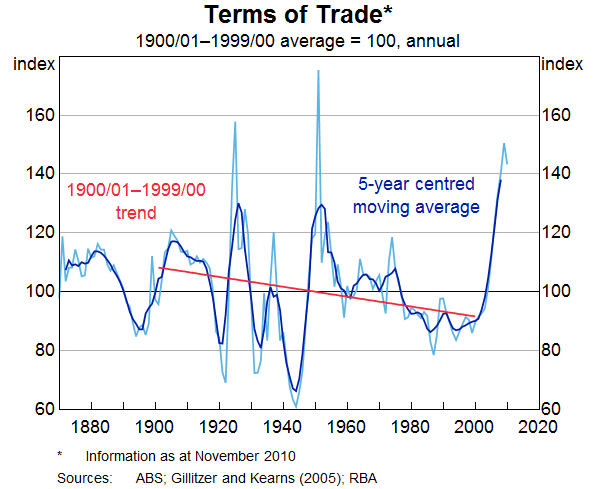
Updating the chart two years later, that assumption was shown to be somewhat pessimistic. The terms of trade peaked in September 2011, about 12 per cent higher than we had previously forecast and 12 months later (Graph 2). The chart was by now sporting a decade-long average, to emphasise not just the level of the terms of trade but the persistence of the episode – even though we were not assuming it was ‘permanent’.
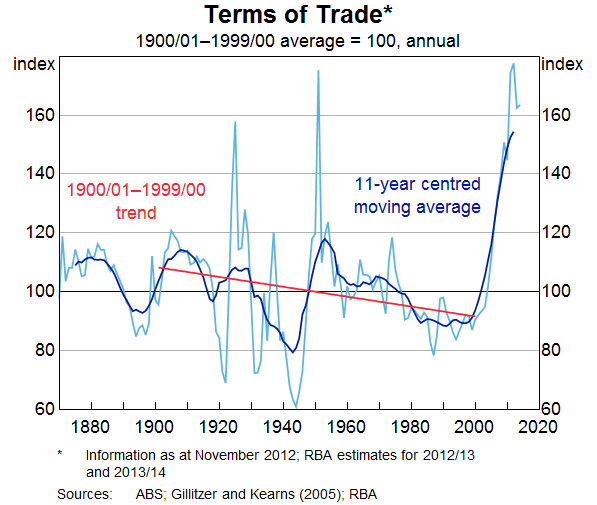
The terms of trade had, however, finally started to decline. It has been a standard assumption since then that they would fall further.
And so they have. In the latest version of the chart, the terms of trade have fallen by about 13 per cent since two years ago and by 22 per cent since their peak (Graph 3). As additional supply of commodities comes on line (including particularly from Australia) and demand grows perhaps more slowly than it has until recently, our best guess is that the terms of trade will fall further but remain at a level well above the standard of the past century. But of course, as this history amply demonstrates, such forecasts – all economic forecasts – have a wide range of uncertainty. This is something the Bank has emphasised more strongly over the past couple of years in our published material.
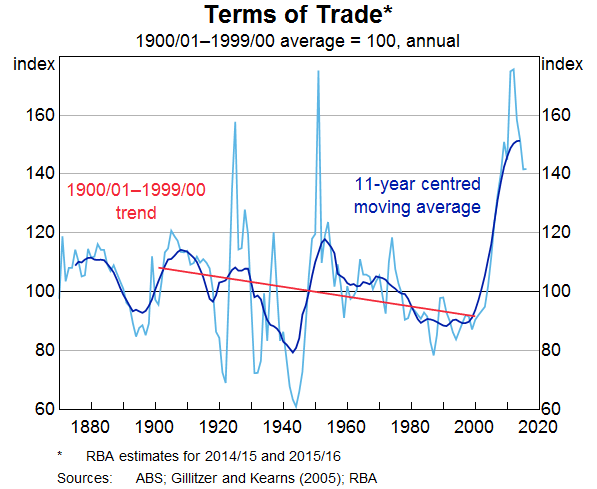
The increase in the terms of trade prompted a surge in investment to increase supply of the commodities that were now commanding very high prices. Two years ago we expected capital expenditure by resources firms to peak at about 8 per cent of GDP and then decline. This updated chart shows what an extraordinary period of investment this was (Graph 4).
The peak has been reached and mining investment has since declined to about 7 per cent of GDP. The detailed information we receive from liaison suggests that this decline has quite a long way to go yet, though there are still some large projects ongoing in the gas sector that will hold investment for a few years at what would once have been seen as very high levels.
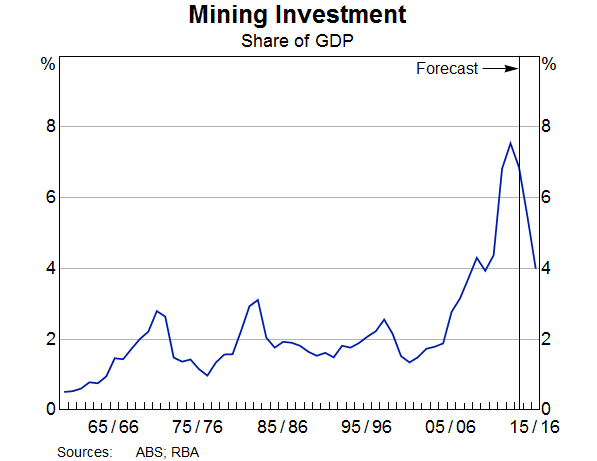
As the expansionary effect of very high levels of mining investment is unwound, even if only partly, other sources of demand will need to play a stronger part in driving growth in the economy. It's very clear that growth in export volumes for resources is very strong. Indeed, the contribution of ‘net exports’ to growth in real GDP has over the past year or two been the largest for more than a decade.
Even so, we need stronger growth outside the resources sector. After several years of quite subdued growth, we estimate that non-mining activity has picked up some speed over the past year (Graph 5).[1] But it would be good to see some further strength here, as the decline in mining investment activity continues. There are sufficient spare labour resources such that we could probably enjoy a couple of years of non-mining sector growth somewhat above its trend rate before we needed to worry too much about serious inflation pressure. The non-resource traded sector could contribute to such growth. The decline in the exchange rate will be of some help here, but the currency remains above most estimates of its fundamental value, particularly given the further declines in key commodity prices in recent months. An exchange rate more in line with fundamentals would be a helpful contributor to a balanced growth outcome.
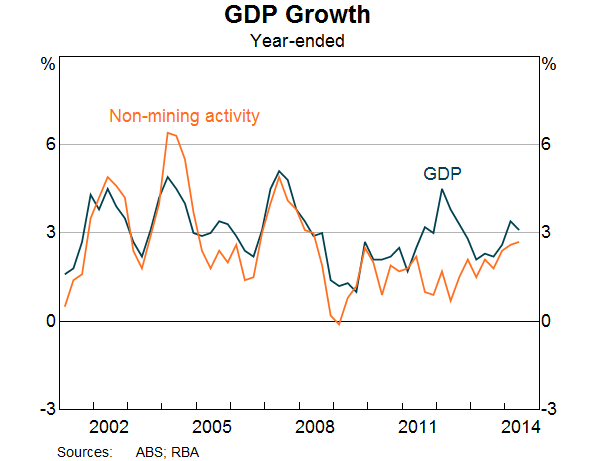
As for domestic sources of demand, an obvious contributor is the set of forces at work in the housing sector. Investment in new and existing dwellings is rising. It ought to be possible, if we are being sensible both on the demand management side and the supply side, for this to go further yet and, more importantly, for the level of activity to stay high for longer than the average cyclical experience. A high level of construction, maintained for a longer period of time, is vastly preferable to a very sharp boom and bust cycle. That alternative outcome might give us a higher peak in the near term, but then a slump in the housing sector at a time when the fall in mining investment is still occurring. A sustained period of strong construction will be more helpful from the point of view of encouraging growth in non-mining activity – and also, surely, from a wider perspective: housing our growing population in an affordable manner.
Considerations such as these are among the reasons we ought to take an interest in developments in dwelling prices, the flow of credit towards housing purchases, and the prudence with which these funds are advanced.[2] It is perhaps opportune to offer a few observations on this topic.
Having fallen in late 2010 and 2011, dwelling prices have since risen, with the median price across the country up by around $100,000 – about 18 per cent – since the low point. Prices have risen in all capitals, with a fair degree of variation: the smallest increase has been in Canberra, at about 6 per cent, and the largest in Sydney, at 28 per cent.
Credit outstanding to households in total is rising at about 6–7 per cent per year. I see no particular concern with that. When we turn to the rate of growth of credit to investors in particular, we see that it has picked up to about 10 per cent per annum over the past six months, with investors accounting for almost half of the flow of new credit.
It is not clear whether this acceleration will continue or abate. It is not clear whether price increases will continue or abate. Furthermore, it is not to be assumed that investor activity is problematic, per se. A proportion of the investor transactions are financing additions to the stock of dwellings, which is helpful. It can also be observed that a bit more of the ‘animal spirits’ evident in the housing market would be welcome in some other sectors of the economy.
Nor, let me be clear, have we seen these dynamics, thus far, as an immediate threat to financial stability. The Bank's most recent Financial Stability Review made that clear.
So we don't just assume that all this is a terrible problem. By the same token, after all we have seen around the world over the past decade, it is surely imprudent not to question the comfortable assumption that it is all entirely benign. A situation where:
- prices have already risen considerably in the two largest cities (where about a third of our population live)
- prices are rising, at present, faster than income by a noticeable margin, and
- an important area of credit growth has picked up to double-digit rates
should prompt a reasonable observer to ask the question whether some people might be starting to get just a little overexcited. Such an observer might want to satisfy themselves that lending standards are being maintained. And they might contemplate whether some suitably calibrated and focused action to help ensure sound standards, and that might lean into the price dynamic, may be appropriate. That is the background to the much publicised comment that the Bank was working with other agencies to see what more could be done on lending standards.
Let's be clear what this is not about. It is not an attempt to restrain construction activity. On the contrary, it is an attempt to stretch out the upswing. Nor is it a return to widespread attempts to restrict lending via direct controls. That era, that some of us remember all too well, was one in which the price of credit was simply too low and credit growth too high all round. We don't have that problem at present. That growth of credit to many borrowers remains moderate suggests that the overall price of credit is not too low. In fact the level of interest rates, although very low, is well warranted on macroeconomic grounds. The economy has spare capacity. Inflation is well under control and is likely to remain so over the next couple of years. In such circumstances, monetary policy should be accommodative and, on present indications, is likely to be that way for some time yet. But for accommodative monetary policy to support the economy most effectively overall, it's helpful if pockets of potential over-exuberance don't get too carried away.
Turning from housing investment to investment more generally, a more robust picture for capital spending outside mining would be part of a further strengthening of growth over time. Some of the key ingredients for this are in place. To date, there are some promising signs of stronger intentions, but not so much in the way of convincing evidence of actual commitment yet. That's often the way it is at this point of the cycle. Firms wait for more evidence of stronger demand, but part of the stronger demand will come from them.
With respect to consumer demand, I should complete the picture by showing an updated version of the relevant chart from last time. In brief, not much has changed. The ratio of debt to income remains close to where it has been for some time (Graph 6). It's rising a little at present because income growth is a bit below trend. Household consumption growth has picked up to a moderate pace and has actually run ahead of income over the past two years. Given that household wealth has risen strongly over that period, and interest rates are low, a modest decline in the saving rate is perhaps not surprising and indeed we think it could decline a little further in the period ahead.[3] As I've argued in the past, however, we shouldn't expect consumption to grow consistently and significantly faster than incomes like it did in the 1990s and early 2000s, given that the debt load is already substantial.
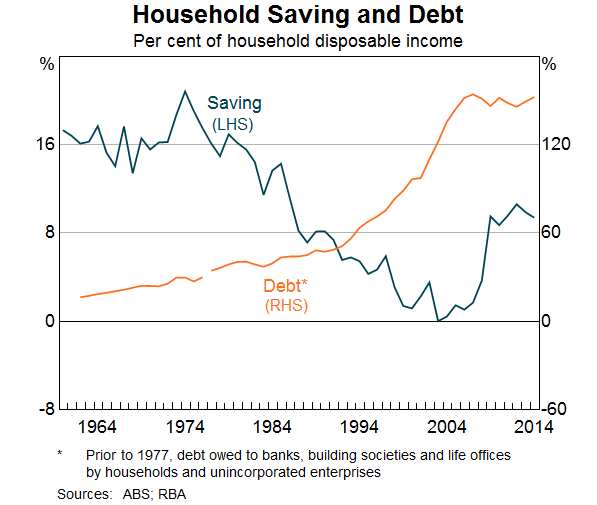
Productivity and competency
When last I was here there were early signs of a pick-up in productivity growth, after a number of years of much slower growth. The most recent data, as measured, confirm that labour productivity has now grown faster over the past three years than it did on average over most of the 2000s (Graph 7). This is observable across a wide range of industries outside of the utilities and mining sectors, where some unusual forces have been at work.
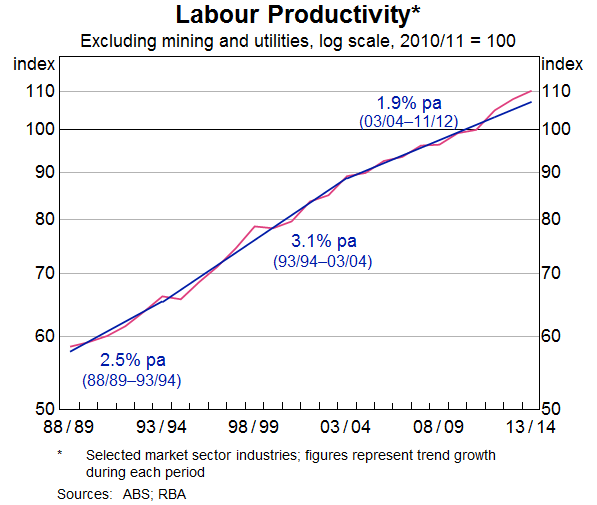
The standard caveats apply, of course, and it is too soon to draw strong conclusions. Nonetheless, the evidence is at least consistent with the hypothesis that productivity growth is on a better track than it was.
Business models have been challenged by the substantial change occurring in the structure of the economy, itself a response to changes in relative prices, in technology, the high exchange rate and other forces. The good news is that businesses can respond to that, and they are doing so.
This process will need to continue and, as you will recall, there is the ‘to do list’ set out by the Productivity Commission.[4] But there is also, I think, a broader set of questions increasingly being asked, about whether our overall business environment is conducive enough to risk-taking and innovation, and whether we are doing enough to develop the relevant competencies.
The questions would include ones like: how easy is it to start a business? If the business fails, as many small ones do, is it easy enough to try again? How easy is it to hire employees? And to let them go if things don't work out? The harder it is to do the latter, the more difficult it is to do the former. Are the rewards to a scientific/research career sufficient to attract a share of the best and brightest? What is the role of private sector support for research and development – as distinct from our rather heavy reliance historically on government support? Is business itself doing enough? Does industry want to get more involved in research and developments? Does academia want to let it? Can private finance – be it banks, venture capital, ‘angel investors’, private equity and so on – get more involved in supporting innovation? Are the entrepreneurs who would like to receive such support prepared to submit to the accompanying discipline?
We are talking about a much broader set of issues than just ‘competitiveness’ as conventionally defined and discussed. We are really coming at the question of whether we have the competencies, across multiple dimensions, to be effective in the modern global economy.
It is hard to evaluate that. These questions are not within my area of responsibility or competence, and I would hesitate to attempt a definitive answer. I note that others more qualified than I am have expressed various views and CEDA itself has done some interesting work relevant to these matters.[5]
But lest it all seem too hard, let me offer one perspective based on something that I have observed reasonably closely. Australia has just hosted the G20. Here was something global, complex and requiring careful leadership. Since we last hosted this gathering in 2006, the scale and complexity have grown almost beyond recognition. These days the Leaders meet annually and there are a host of ministerial and other meetings at various levels – around 60 formal meetings and related seminars in a year. There is the B20, C20, L20, Think 20, Youth 20 and various other groups. All these groups need to be accommodated and engaged. They all have their own agenda, but somehow we have to make them come together with the G20's main agenda. At the same time, the main G20 agenda seriously needed to be streamlined and focused. The G20 needed to show that it could effectively meet the challenges of securing better economic performance – ‘strong, sustainable and balanced growth’.
Australia is one of the smaller members of this group by GDP and certainly by population. We cannot match the scale of human resources available to larger countries in the various workstreams. We are geographically remote. We are not powerful enough simply to command attention or demand others follow our lead. If we are to be effective, we have to try harder than the average country. And it was our job this year to run this unwieldy body effectively.
The feedback I have received from my counterparts has been universally and strongly positive. They judge that the Australian presidency has, by the metrics that count, been very successful. Prodigious efforts by exceptionally dedicated people in the public and private sectors ensured improvements to the agenda, process, logistics and conduct of meetings. Substantive things have been achieved by way of pro-growth commitments that, if carried through by the various jurisdictions over time, will make a material difference to wellbeing around the world.
Achieving all this was costly in human and financial resources. It required coordination between multiple organisations. It was not on the scale of running the Olympic Games, but it was nonetheless a big deal and it was done well. It wasn't achieved by any effortless superiority; it owed to careful preparation, astute use of some of our natural advantages and continuous effort over a long period. But that's where success always comes from, really. The only question is: how badly do we want it?
Responsibility for the G20 now passes to Turkey. We can bask in the glow of success for a few weeks and then get on to other matters. The point simply is that this has gone well as a result of the determined efforts of a range of people who were clear about what they wanted to achieve and who mobilised the necessary resources and effort to get there.
One other result of Australia's leadership of the G20 is that the whole issue of infrastructure is well and truly on the table. No one doubts the need for infrastructure provision and it has clear economic attractions. Spending on infrastructure supports aggregate demand during construction but, if done well, also augments the economy's supply capacity for the long run.
It is also clear from the various discussions over the past year that there is not a shortage of capital in global markets to fund infrastructure projects. The issues to be overcome don't include finding the money. They concern appropriate project selection criteria, long-term planning, governance, contract design, appropriate risk sharing between public and private sectors, pricing usage of the infrastructure and so on.
There is an opportunity here, including for Australia, to do something of value over the years ahead. Of course, we will need to be serious and to put in the effort over an extended period – in all the above areas. If we don't put in that effort, not much actual infrastructure will be delivered. But if we are serious, a lot could be achieved. I imagine that the Committee for the Economic Development of Australia would be keen to be involved.
Conclusion
I have reached the limits of our time this evening. Australia's economy is continuing to grow, moderately. It has been responding in ways you would expect to the remarkable set of circumstances it has faced over the past decade. There is continuing adjustment ahead and doubtless no shortage of challenges.
But beyond these challenges of the next couple of years, maximising our economic possibilities in the modern world requires sustained efforts at adaptation and innovation, at doing things better and, perhaps most of all, a willingness to take the occasional risk. I would be confident that we have, or can develop, the relevant capabilities. The only question is whether we are sufficiently determined to succeed in deploying them.
Endnotes
I thank Elliott James for assistance in preparing these remarks. [*]
Estimating non-mining activity requires an estimate of imports used in mining activity. This is a rather imprecise exercise and so the estimates for non-mining activity should be considered as very approximate. [1]
The Reserve Bank does not take a doctrinaire view of the ‘correct’ level of house prices. The endless discussion about whether or not the level of prices constitutes, at any one time, a ‘bubble’ is not very productive. We can observe that, for more than a decade, the level of prices relative to disposable income has been noticeably higher than it used to be, and not just in Australia. If that is a bubble, it is a remarkably long-lived and widespread one. But even if we lose no time arguing over that question, it is still the fact that prices go up AND down, and that these trends matter for the economy. If we are interested in strong and steady growth, we have an interest in dwelling prices and indeed all asset prices. [2]
See Kent, C (2014), ‘The Business Cycle in Australia’, Address to the Australian Business Economists, Sydney, 13 November. [3]
See Banks G (2012), ‘Productivity Policies: The “To Do” List’,
Speech at the Economic and Social Outlook Conference, ‘Securing the
Future’, Melbourne, 1 November. Available at
<http://www.pc.gov.au/__data/assets/pdf_file/0009/120312/productivity-policies.pdf>.
[4]
See Chief Scientist for Australia (2014), ‘Senate Inquiry Submission –
Australia's Innovation System’, Submission to Senate Inquiry into
the Australian Innovation System, 23 July. Available at
<http://www.chiefscientist.gov.au/wp-content/uploads/Chief-Scientist-submission-to-Senate-inquiry-into-Australias-Innovation-System1.pdf>;
and CEDA (2013), ‘Australia Adjusting: Optimising National Prosperity’,
November. Available at <http://www.ceda.com.au/media/338287/cedaaustadjusting_web.pdf>.
[5]
Bibliography
Gillitzer C and J Kearns (2005), ‘Long-term Patterns in Australia's Terms of Trade’, RBA Research Discussion Paper No 2005-01.